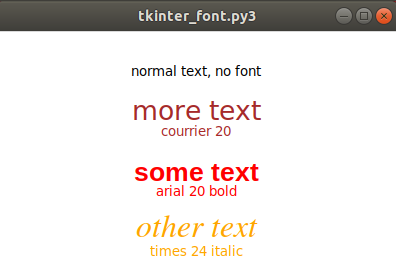<- previous index next ->
Cover some loose ends.
Get your term project discussed. Start your project!
Review lectures and homework.
Quiz 1 will be: Open Book, Open Note, Open Computer.
One hour time limit.
(You may bring your own laptop)
(Not the "Study Guide" or copies thereof.)
(Read the instructions and follow the instructions.)
(Read carefully, answer the question that is asked.)
Some questions on concepts. e.g. mouse events, keyboard events, color,
menus, fonts, writing files
Some questions on code. Based on code displayed on course WEB pages.
Questions on color, know the following:
Primary colors for pigment paint, water and oil, are Red, Blue, Yellow.
These are subtractive colors applied to a white background.
Primary colors for computer displays are Red, Green, Blue.
These are additive colors, each may be 0.0 to 1.0 floating point,
or 0 to 255 integer, typically an 8 bit byte.
RGB 0,0,0 is black, 255,255,255 is white, 255,0,0 is red
Primary colors for color printers are Cyan, Magenta, Yellow.
These are subtractive colors applied to a white background.
There is also typically Black.
Color TV uses a very different method, YIQ that has
intensity Y, and uses phase angle IQ for color.
Not all RGB colors can be converted to YIQ.
An RGB image can be shown as gray scale, 0.0 to 1.0,
using 0.299 *R + 0.587 *G + 0.114 *B
with R, G, B in range 0.0 to 1.0
A fourth byte may be used to get 32 bit color, RGBA,
the A is alpha, 0 is transparent, 255 is opaque,
128 or 0.5 allows some of another image to come through.
Toolkits such as OpenGL with GLUT are available on
all operating systems.
Graphics in Java, Python and other languages are
very portable to all operating systems.
Motif is specific to systems with XWindows being
available, including all versions of Unix, Linux, MacOSX.
The painters algorithm, draws from a list, farthest back
object first.
Fonts may appear any size on a computer screen.
Only on paper, properly rendered, is a 72 point font
one inch high. Fonts may be stored in various formats.
Your software may use any font on your computer,
many available, that are in a format your software can read.
A font face many have names such as Times Roman, Helvetica,
Courier, etc. Some are fixed spacing, some are proportional
spacing.
A font type may be bold, italic, outline, underline, and
many others. Not all fonts are available in all types.
tkinter_font.py3 source code
 No Email or instant messaging during the exam.
The exam has not been written, thus number of questions unknown,
type of questions unknown. (Typically 40 to 50 questions, many
multiple choice.)
Then, get the big picture:
Our known Universe
No Email or instant messaging during the exam.
The exam has not been written, thus number of questions unknown,
type of questions unknown. (Typically 40 to 50 questions, many
multiple choice.)
Then, get the big picture:
Our known Universe
<- previous index next ->
Many web sites on Java GUI, AWT, Swing, etc.
Many web sites on Python wx, tk, qt, etc.
 No Email or instant messaging during the exam.
The exam has not been written, thus number of questions unknown,
type of questions unknown. (Typically 40 to 50 questions, many
multiple choice.)
Then, get the big picture:
Our known Universe
No Email or instant messaging during the exam.
The exam has not been written, thus number of questions unknown,
type of questions unknown. (Typically 40 to 50 questions, many
multiple choice.)
Then, get the big picture:
Our known Universe
 No Email or instant messaging during the exam.
The exam has not been written, thus number of questions unknown,
type of questions unknown. (Typically 40 to 50 questions, many
multiple choice.)
Then, get the big picture:
Our known Universe
No Email or instant messaging during the exam.
The exam has not been written, thus number of questions unknown,
type of questions unknown. (Typically 40 to 50 questions, many
multiple choice.)
Then, get the big picture:
Our known Universe